The Square of Pegasus was where present time began, not only where Seven Macaw had been
dethroned but also where each night the origin of our time could be seen
illustrated
in the sky.
I remembered a glyph
late on side b of the C text:

|
PYTHAGOREAN
SCHOOL |
|
limited |
odd |
one |
right |
male |
good |
motion |
light |
square |
straight |
|
unlimited |
even |
many |
left |
female |
bad |
rest |
darkness |
oblong |
curved |
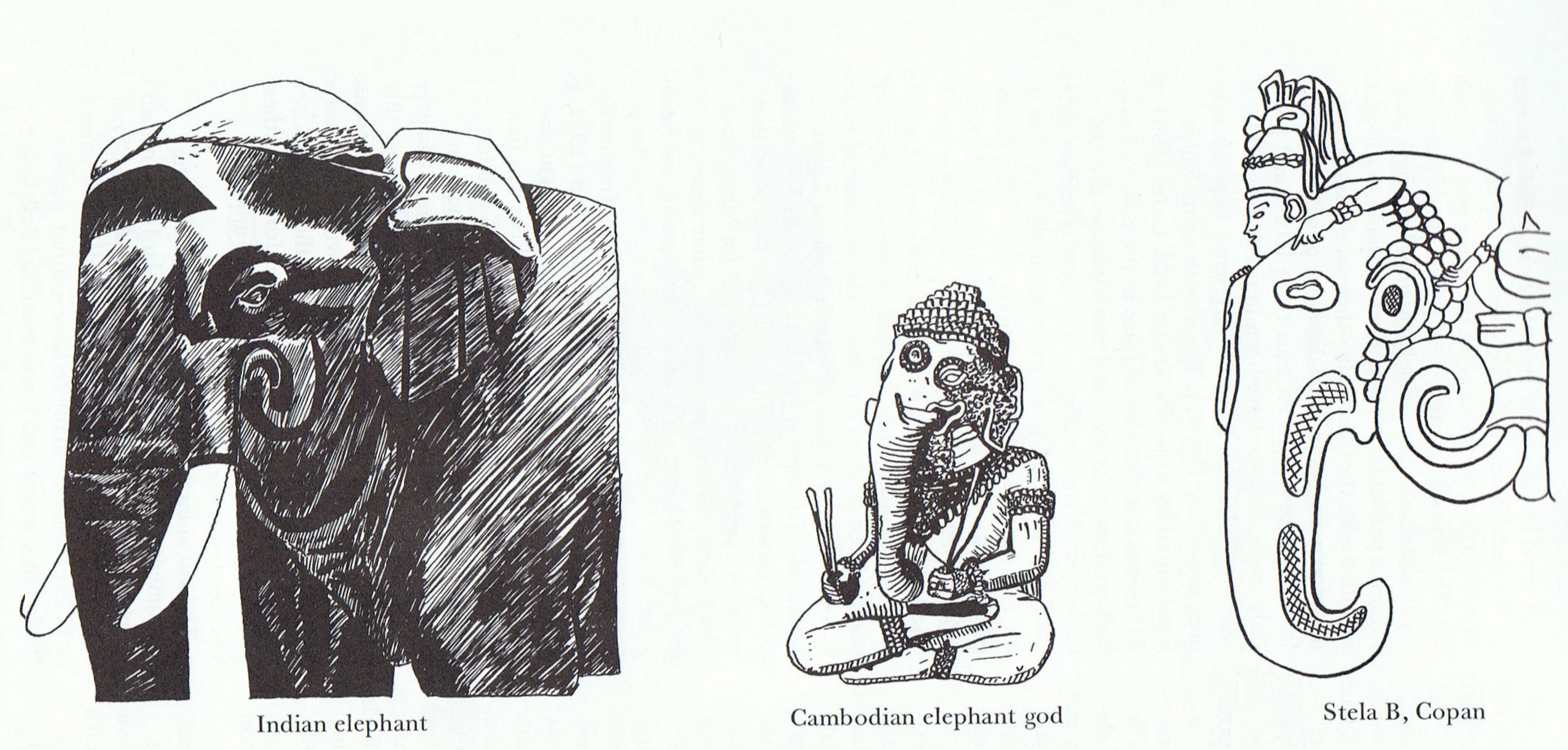
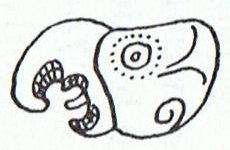
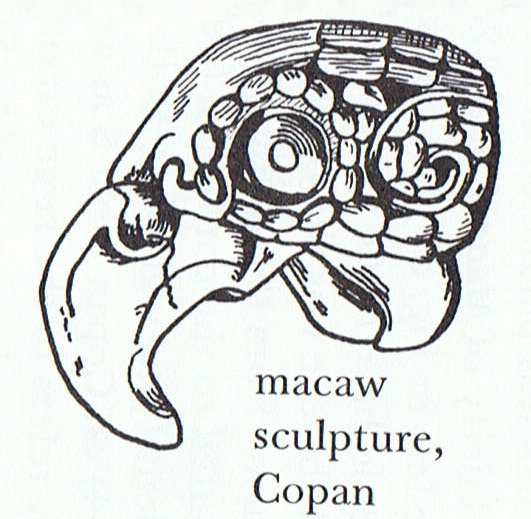
...
Let us now return
to our map, which also incorporates a triangle representing the
Delta. Its other main components are the three parallel
meridians. The eastern meridian is at longitude 32░
38'
east - the official eastern border of Ancient Egypt from the
beginning of dynastic times. The western meridian is at
longitude 29░50'
east, the official western border of ancient Egypt. The central
meridian is at longitude 31░
14'
east, exactly midway between the other two (1░
24' away
from each). What we now have is a representation of a strip on
the surface of planet earth that is exactly 2░
48' wide. How long is this strip? Ancient Egypt's official
northern and southern borders (which bore no more relationship
to settlement patterns than the official eastern and western
boundaries) are marked by the horizontal lines at the top and
bottom [rather bottom and top, I think] of the map and are
located respectively at
31░06' north and 24░
06' north.
The northern
border, 31░
06' north, joins the two outer ends of the estuary of the Nile.
The southern border, 24░06'
N, marks the precise latitude of the island of Elephantine at
Aswan (Seyne) where an important astronomical and solar
observatory was located throughout known Egyptian history. It
seems, that this archaic land, sacred since time began - the
creation and habitation of the gods - was originally conceived
as a geometric construct exactly seven terrestrial degrees in
length.
Within this construct, the Great Pyramid appears to have been
carefully sited as a geodetic marker for the apex of the Delta
...
At the time when Hyadum II was at 0h the
Foundation Stone (Alcyone) was rising with the Sun in day 68
(*MARCH 9) when the Full Moon was in day 251 (*SEPTEMBER 8
≈ 78):
|
*SEPTEMBER 8 |
9 |
10 |
11 (254) |
12 (*175) |
 |
 |
 |
 |
 |
|
Ga7-6 |
Ga7-7 |
Ga7-8 (177) |
Ga7-9 |
Ga7-10 |
|
κ Serpentis (239.3), δ Cor.
Borealis,
TIĀNRŪ
= μ Serpentis (239.5), χ Lupi,
(239.6), ω Serpentis (239.7),
BA
= ε Serpentis, χ Herculis (239.8). κ
Cor. Borealis, ρ Serpentis (239.9) |
λ Librae (240.0), β Tr. Austr.
(240.3), κ Tr. Austr. (240.4), ρ
Scorpii (240.8) |
Iklīl al Jabhah-15 /
Anuradha-17 /
Room-4 (Hare)
ξ Lupi, λ Cor. Bor.(241.1),
ZHENG
= γ Serpentis, θ Librae (241.2),
VRISCHIKA (Scorpion)
= π Scorpii (241.3), ε Cor. Borealis
(241.5), DSCHUBBA
(Forehead)
= δ Scorpii (241.7), η Lupi (241.9) |
υ Herculis (242.3), ρ Cor. Borealis
(242.4), ι Cor. Borealis (242.5), θ
Draconis (242.6), ξ Scorpii (242.7)
SCHEDIRr
(α Cassiopeiae)
|
16h (243.5)
ACRAB (Scorpion)
= β Scorpii,
JABHAT AL ACRAB (Scorpion's
Forehead)
= ω Scorpii (243.3), θ Lupi,
RUTILICUS
= β Herculis (243.5),
MARFIK (Elbow)
= κ Herculis (243.7), φ Herculis
(243.8) |
|
November 15 |
16 (320) |
17 |
18
(*242) |
19 |
|
░November 11 |
12 (*236) |
13 |
14 (318) |
15 |
|
'October 19 |
20 |
21 (*214) |
22 (295) |
23 |
|
"October 5 |
6 (*199) |
7 (280) |
8 |
9 |
|
Temennu-3 (Foundation Stone)
ALCYONE
(56.1),
PLEIONE (28 Tauri),
ATLAS
(27) (56.3) |
MENKHIB (Next
to the Pleiades) = ζ Persei
(57.6)
PORRIMA
(γ Virginis)
|
ε Persei
(58.5), ξ Persei (58.5),
ZAURAK (The Boat)
= γ Eridani (58.9) |
λ Tauri
(59.3), ν Tauri (59.9) |
4h
(60.9)
JĪSHUĬ
(Piled-up Waters) = λ Persei
(60.7)
COR
CAROLI (α Canum Ven.)
|
|
May 16 (136 = 2 * 68) |
17 |
18 |
19 |
20 |
|
░May 12 |
13 |
14 |
15 (500) |
16 (136) |
|
'April 19 |
20 |
21 (111) |
22 (*32) |
23 (478) |
|
"April 5 (95) |
6 |
7 |
8 (*383) |
9 (464) |
|
*MARCH 9 (68) |
10 (*354 =*381 - *27) |
11 |
12 |
13 |
And in the C text we have found Alcyone
illustrated in Cb2-6:
|
November
13 |
14 |
15 |
16 (320
= 80 + 240) |
|
κ Librae
(237.2), ι Serpentis (237.4), ψ▓ Lupi, ρ Oct.
(237.5), γ Cor. Borealis, η Librae (237.7), COR
SERPENTIS
= α Serpentis (237.9) |
π Cor.
Borealis,
UNUK
ELHAIA (Necks of the Serpents)
= λ Serpentis (238.1),
CHOW
= β Serpentis (238.6) |
κ
Serpentis (239.3), δ Cor. Borealis,
TIĀNRŪ
= μ Serpentis (239.5), χ Lupi, (239.6), ω Serpentis
(239.7),
BA
=
ε Serpentis, χ Herculis (239.8). κ Cor. Borealis, ρ
Serpentis (239.9) |
λ Librae
(240.0), β Tr. Austr. (240.3), κ Tr. Austr. (240.4),
ρ Scorpii (240.8) |
 |
 |
 |
 |
|
Cb2-4 (420) |
Cb2-5 |
Cb2-6 (414
+ 4 + 4) |
Cb2-7
(31) |
| te
ua |
koia ra |
kua
tuku ki to mata - ki tona tukuga |
e
kiore - henua - pa rei |
|
δ Persei (54.7) |
Al Thurayya-27 /
Krittikā-3 |
MENKHIB (Next to the Pleiades) = ζ Persei
(57.6)
PORRIMA (γ
Virginis)
|
|
TAU-ONO
(Six Stones)
ATIKS = ο Persei,
RANA (Frog) = δ Eridani
(55.1), CELAENO (16
Tauri), ELECTRA (17),
TAYGETA (19), ν Persei
(55.3), MAIA (20),
ASTEROPE (21),
MEROPE (23) (55.6) |
Temennu-3 (Foundation
Stone) Hairy Head-18
(Cockerel)
ALCYONE (56.1),
PLEIONE (28 Tauri),
ATLAS (27) (56.3) |
|
May 14 |
15 |
16 (136
= 80 + 56) |
17 |
From May 16 (Cb2-6) up to and including
υ Pegasi in March 10 there were 366 (*JANUARY 1) -
68 (*MARCH 9) + 1 = 299 days:
|
295 |
CLOSE TO THE SUN: |
|
29 JUNE |
SIRIUS (181) |
1 JULY |
2 |
3 (254 - 70) |
|
*JULY 1 |
2 |
3 (*104 =
*172 - *68) |
4 |
5 |
 |
 |
 |
 |
 |
|
Ga4-23 |
Ga4-24 |
Ga4-25 (108) |
Ga4-26 |
Ga4-27 |
|
φ Leonis
(170.0),
ALULA
(First Spring of the Gazelle)
= ξ, ν Ursae
Majoris (170.5),
LABRUM
(Lip)
= δ
Crateris (170.6) |
σ Leonis
(171.1), λ Crateris (171.6), ι Leonis, ε Crateris
(171.9) |
γ Crateris,
π Centauri (172.0), κ Crateris (172.5), τ Leonis
(172.8)
GREDI (α
Capricorni)
|
ο╣ Centauri
(173.8) |
GIAUZAR
(Poison Place)
= λ Draconis (174.0), ξ Hydrae (174.3), ο▓ Centauri, λ
Centauri (174.8) |
|
September 7 |
8 |
9 (*172) |
10 |
11 (254) |
|
░September 3 |
4 |
5 (*168) |
6 |
7 (250) |
|
'August 11 |
12 (*144) |
13 |
14 |
15 (227) |
|
"July 28 |
29 (*130) |
30 |
31 |
'August 1
(213) |
|
CLOSE TO THE FULL
MOON: |
|
29 DECEMBER
|
SIRIUS (364) |
31 |
1 JANUARY |
2 |
|
*DECEMBER 31 |
*JANUARY 1 |
2 |
3 (368) |
4 |
|
CROSS-BARS |
ο Gruis,
Snowball Nebula = NGC7662
Andromedae (355.0), τ Oct. (355.3) |
no star listed (356) |
ι Phoenicis (357.3), ι
Piscium (357.4), λ Andromedae (357.9) |
|
ο Cephei (353.3),
KERB (Bucket Rope) = τ Pegasi
(353.6) |
κ Piscium (354.2), θ Piscium
(354.4),
υ Pegasi (354.9) |
|
March 9 |
10 (*354) |
11 |
12 |
13 (72) |
|
░March 5 |
6 (*350) |
7 |
8 |
9 (68) |
|
'February 10
(41) |
11 |
12 |
13 (*329) |
2-14 |
|
"January 27 |
28 |
29 (*314) |
30 |
31 |
Counting similarly ahead in the C text we will
reach 30 JUNE, where 30 DECEMBER (364) was at the Full Moon,
and 2 days later the Full Moon would have arrived to 1 JANUARY:
|
295 |
CLOSE TO THE SUN: |
|
29 JUNE |
SIRIUS (181) |
1 JULY |
2 |
3 (254 - 70) |
|
*JULY 1 |
2 |
3 (*104 =
*172 - *68) |
4 |
5 |
|
September 7 |
8 (*171) |
9 |
10 |
11 (254) |
 |
 |
 |
 |
 |
|
Cb13-28 |
Cb13-29
(720) |
Cb13-30
(329) |
Cb14-1 |
Cb14-2 |
| te
hau tea |
hokohuki ki te niu |
te
tamaiti |
Kua
pu ia |
tagata ariga erua |
|
φ Leonis
(170.0),
ALULA
(First Spring of the Gazelle)
= ξ, ν Ursae
Majoris (170.5),
LABRUM
(Lip)
= δ
Crateris (170.6) |
σ Leonis
(171.1), λ Crateris (171.6), ι Leonis, ε Crateris
(171.9) |
γ Crateris,
π Centauri (172.0), κ Crateris (172.5), τ Leonis
(172.8) GREDI (α
Capricorni)
|
ο╣ Centauri
(173.8) |
GIAUZAR
(Poison Place)
= λ Draconis (174.0), ξ Hydrae (174.3), ο▓ Centauri, λ
Centauri (174.8) |
|
CLOSE TO THE FULL
MOON: |
|
CROSS-BARS |
ο Gruis,
Snowball Nebula = NGC7662
Andromedae (355.0), τ Oct. (355.3) |
no star listed (356) |
ι Phoenicis (357.3), ι
Piscium (357.4), λ Andromedae (357.9) |
|
ο Cephei (353.3),
KERB (Bucket Rope) = τ Pegasi
(353.6) |
κ Piscium (354.2), θ Piscium
(354.4),
υ Pegasi (354.9) |
|
March 9
(68) |
10
(*354) |
11 |
12 |
13 |
|
*DECEMBER 31 |
*JANUARY 1 |
2 |
3 (368) |
4 |
|
29 DECEMBER
|
SIRIUS (364) |
31 |
1 JANUARY |
2 |
Here there was a person with two faces (ariga erua), said Metoro, possibly referring to the god of January:

Also Seven Macaw seems to have had a pair of
faces, one on top of the other, although these were both
looking back in time (Mayan-style), back into the past:
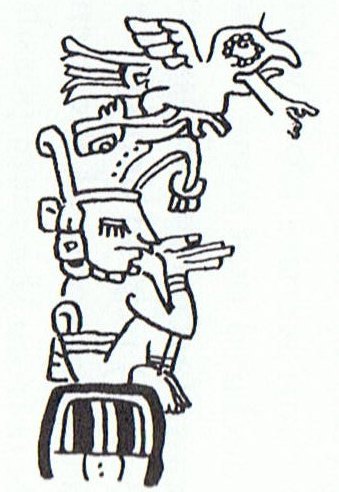
The 3rd
person in this composition was evidently not awake but 'dormant'
(dead, cimi) - like a 'do(o)rmouse':

And he was sitting on a seat which could have
contained the last nights of the year, because the design
resembles that for Vayeb:

 |
 |
 |
 |
|
1 Pop
(20) |
2 Uo |
3 Zip |
4
Zotz
(80) |
 |
 |
 |
 |
|
5
Tzek
(100) |
6
Xul |
7
Yaxkin |
8
Mol
(160) |
|
RAIN: |
 |
 |
 |
 |
|
9
Ch'en
(180) |
10
Yax |
11
Sac |
12
Ceh
(240) |
 |
 |
 |
 |
|
13
Mac
(260) |
14
Kankin |
15
Moan
(300) |
|
BREAK (paxih) |
 |
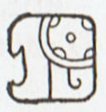 |
 |
 |
|
16
Pax (320) |
17
Kayab |
18
Cumhu |
19
Vayeb (365) |
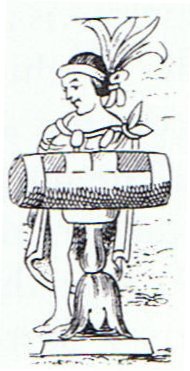
... The tun
glyph was identified as a wooden drum by Brinton ... and
Marshal H. Saville immediately accepted it ... [the figure
above] shows the Aztec drum representation relied on by
Brinton to demonstrate his point. It was not then known that
an ancestral Mayan word for drum was *tun: Yucatec
tunkul 'divine drum' (?); Quiche tun 'hollow log
drum'; Chorti tun 'hollow log drum' ...
|


































